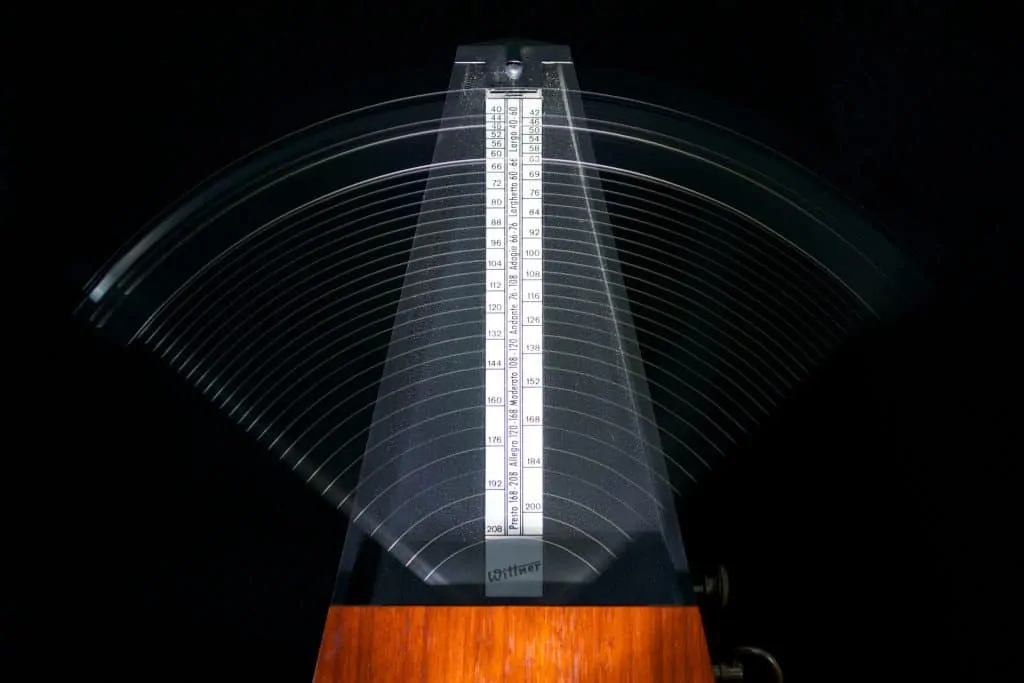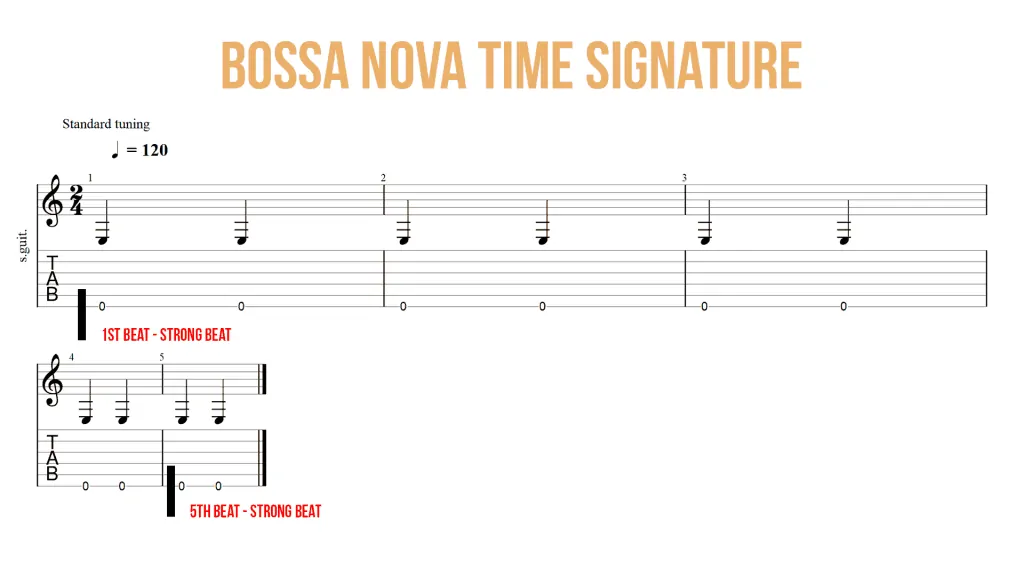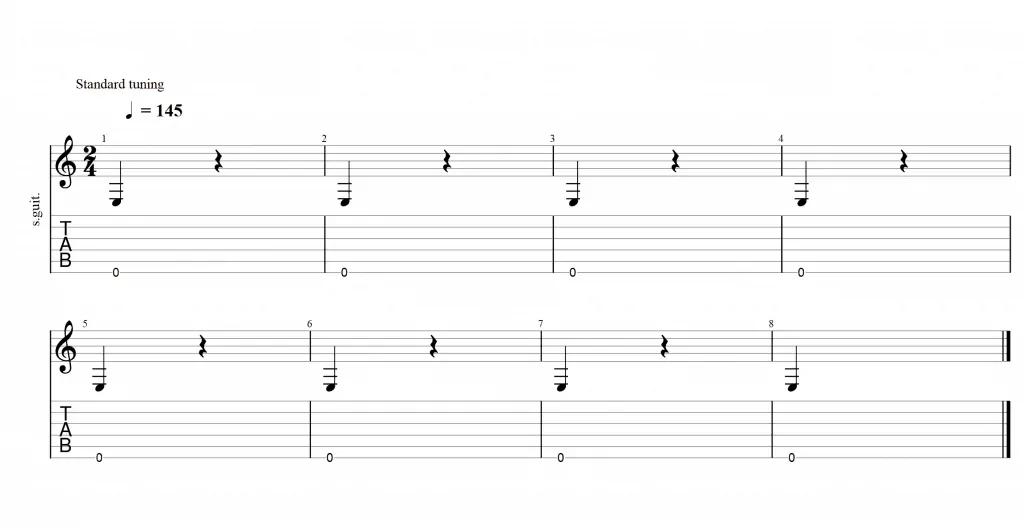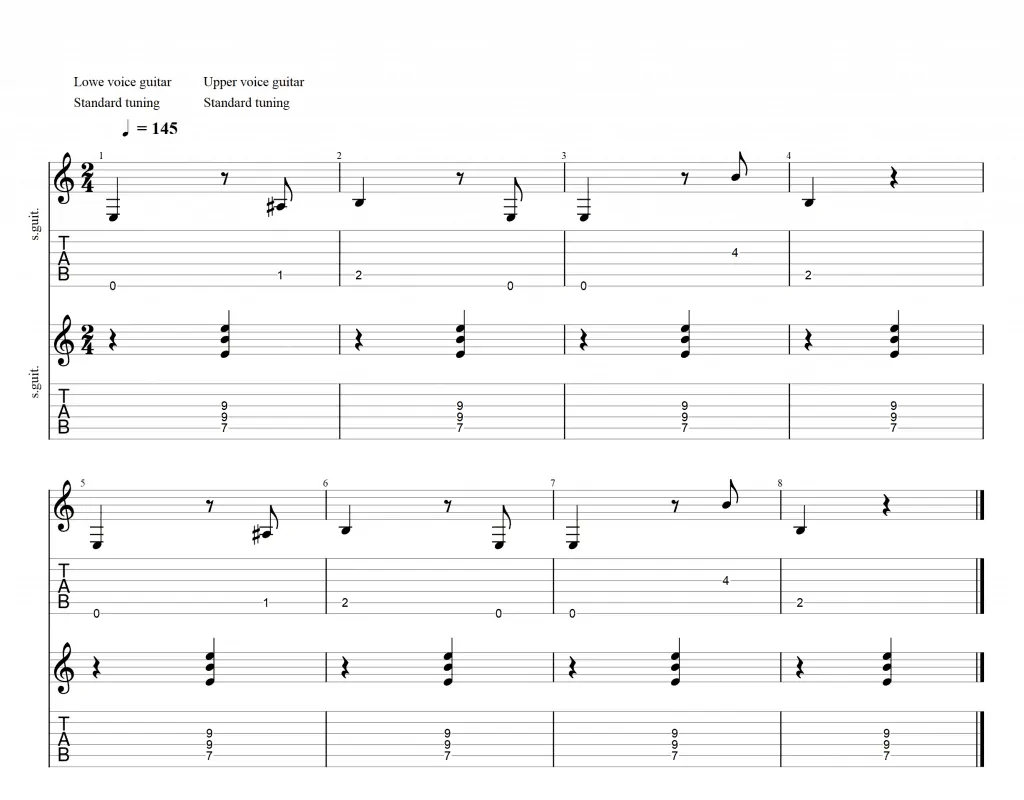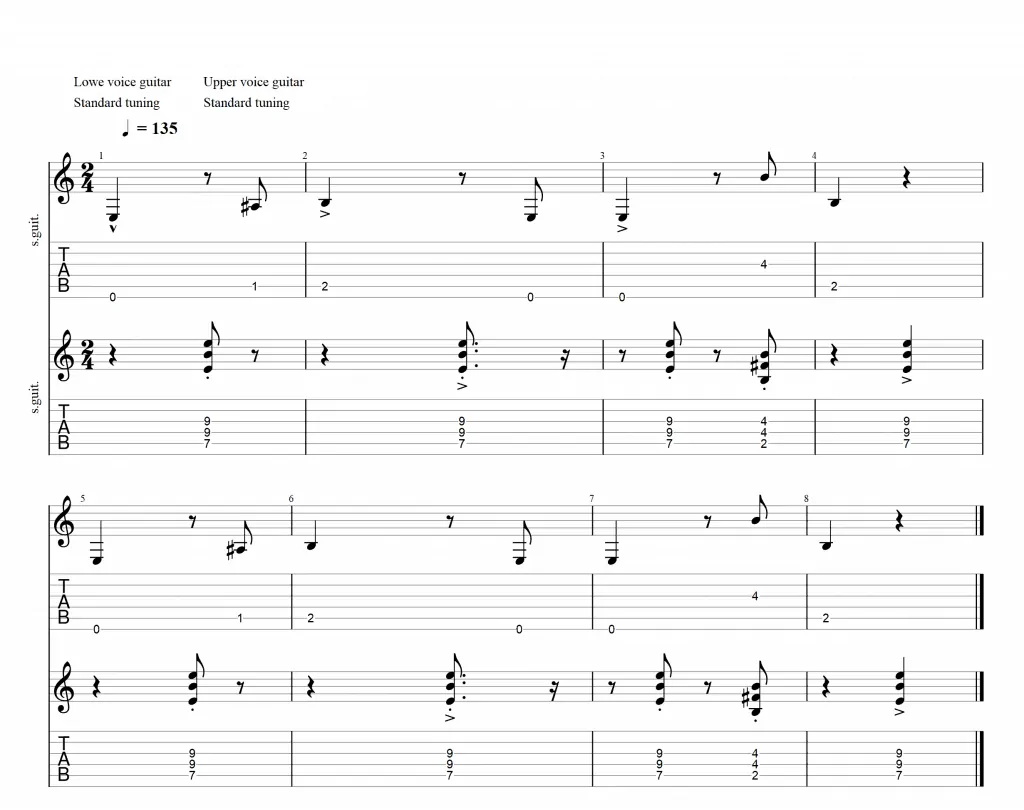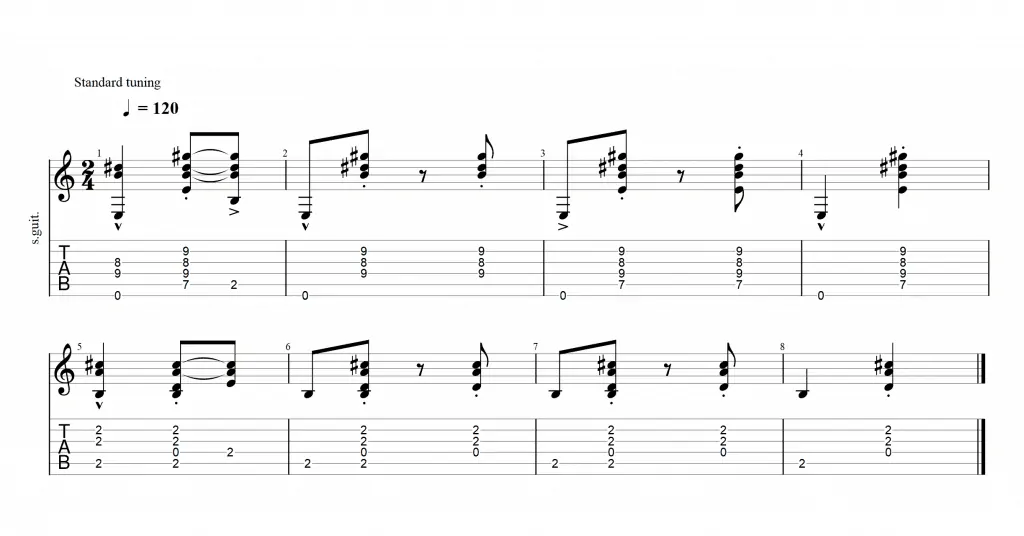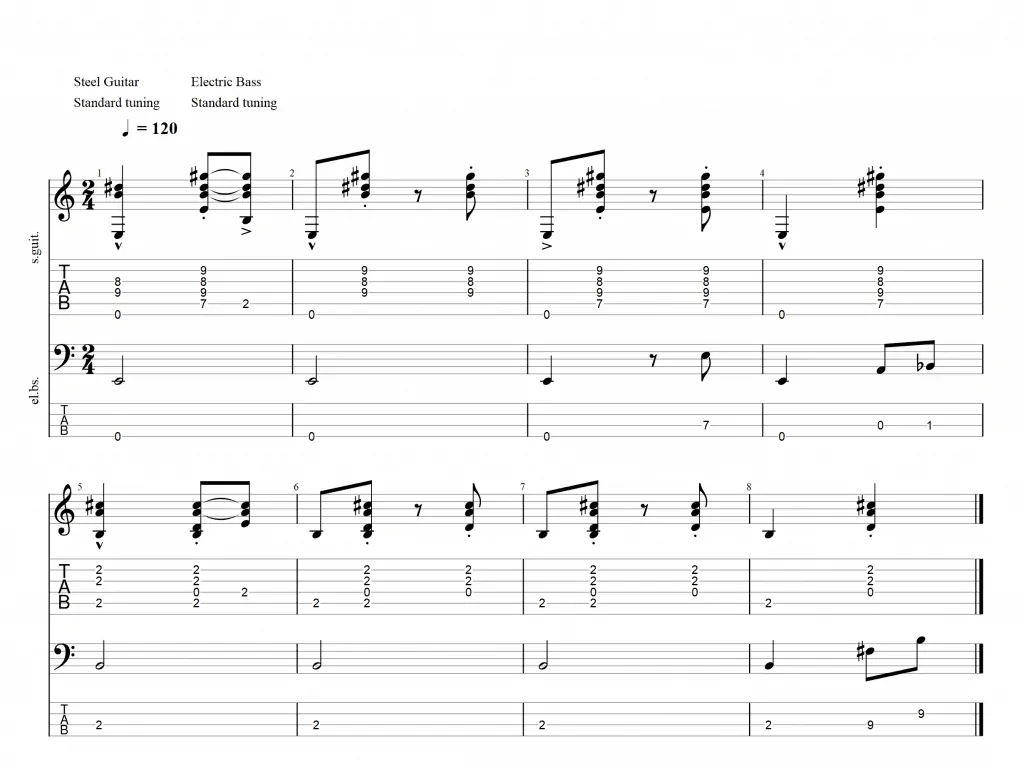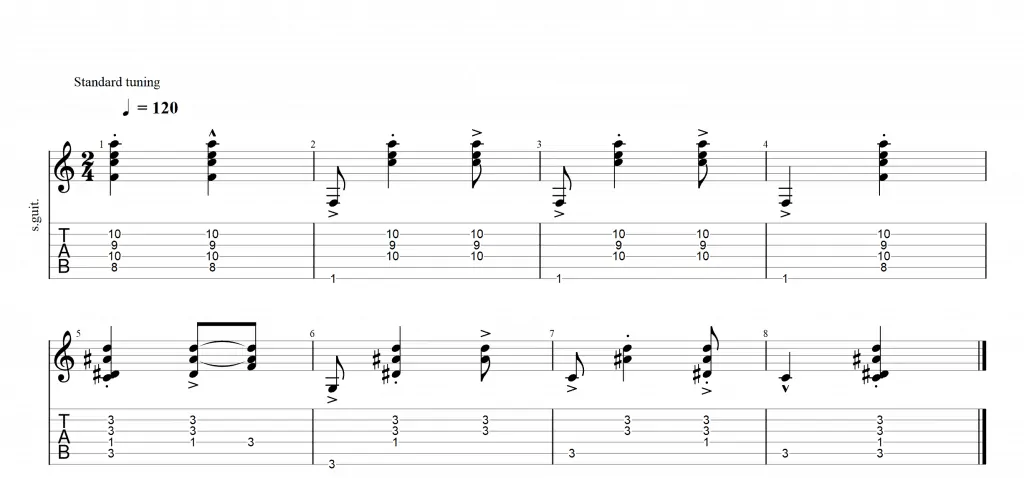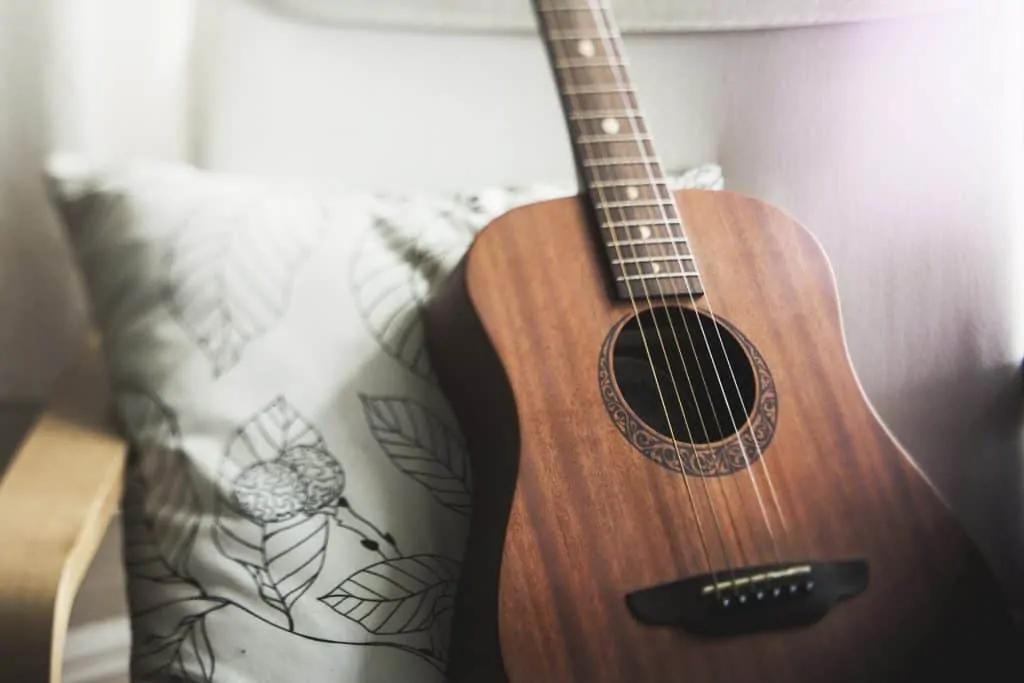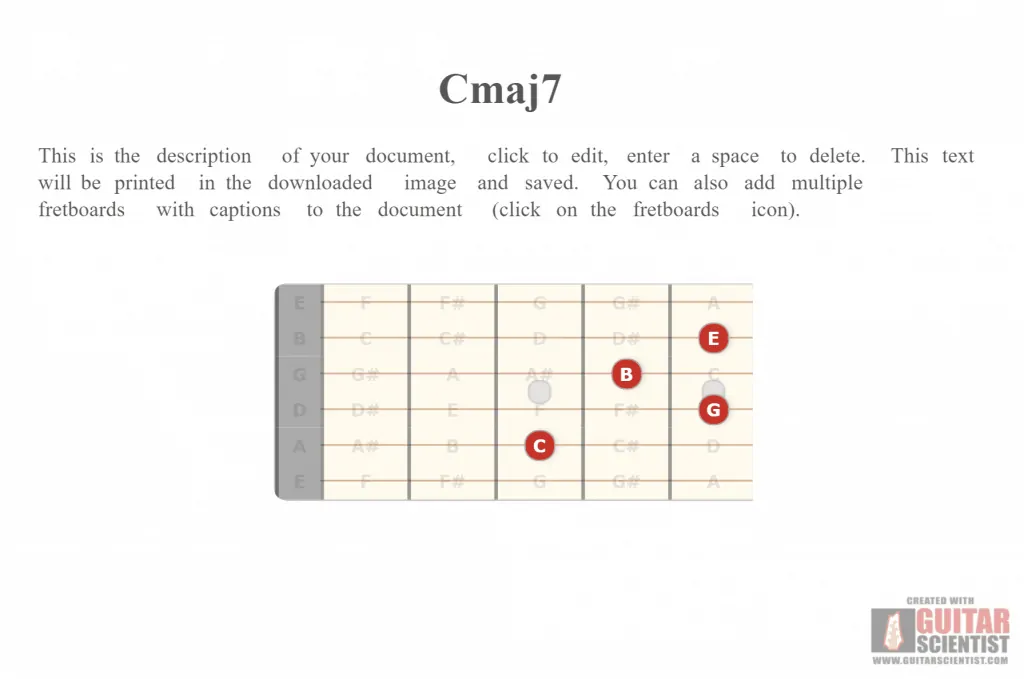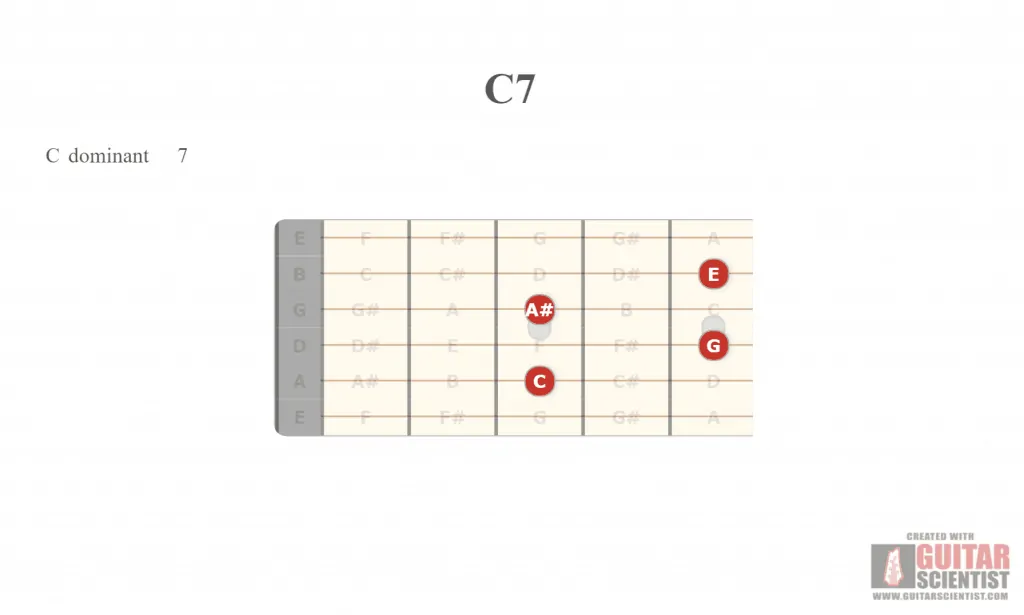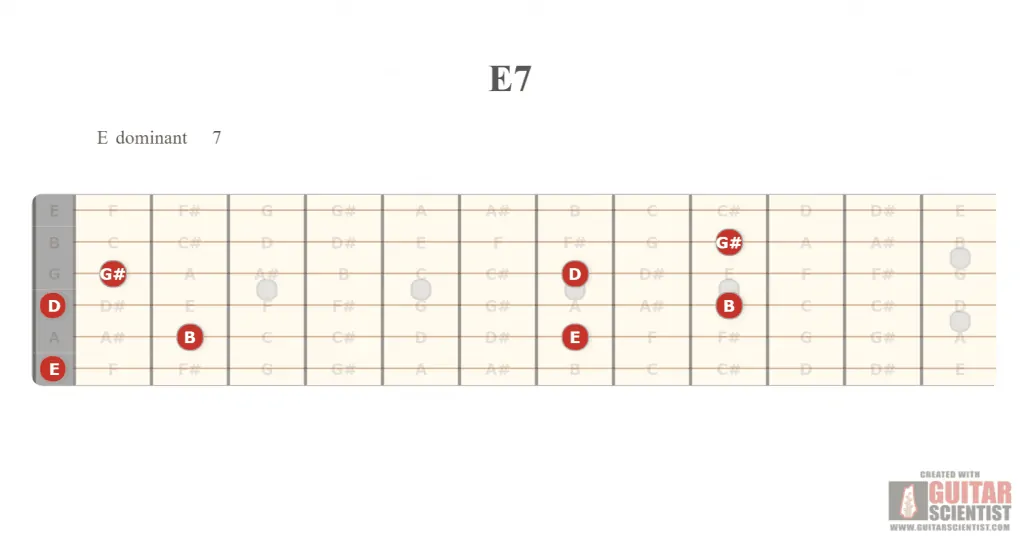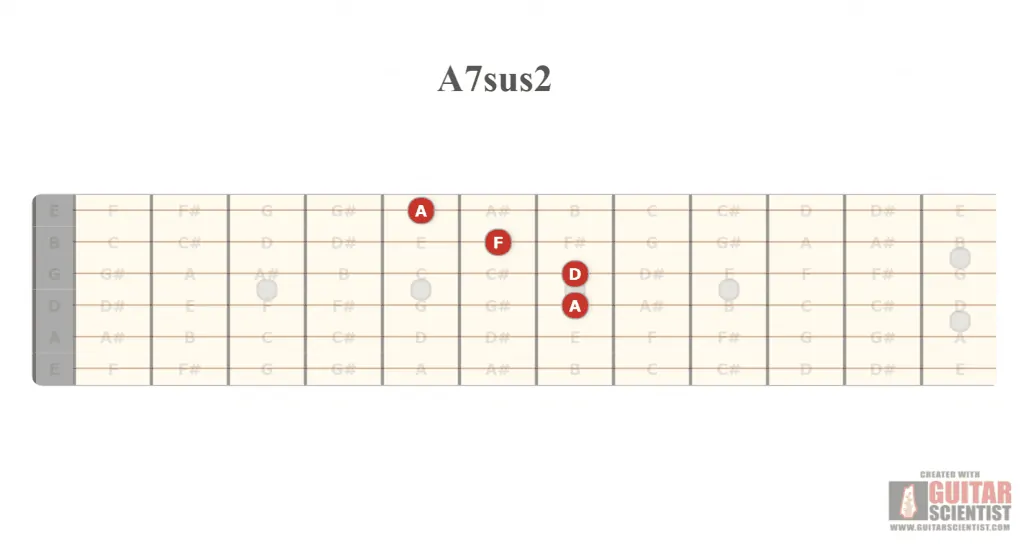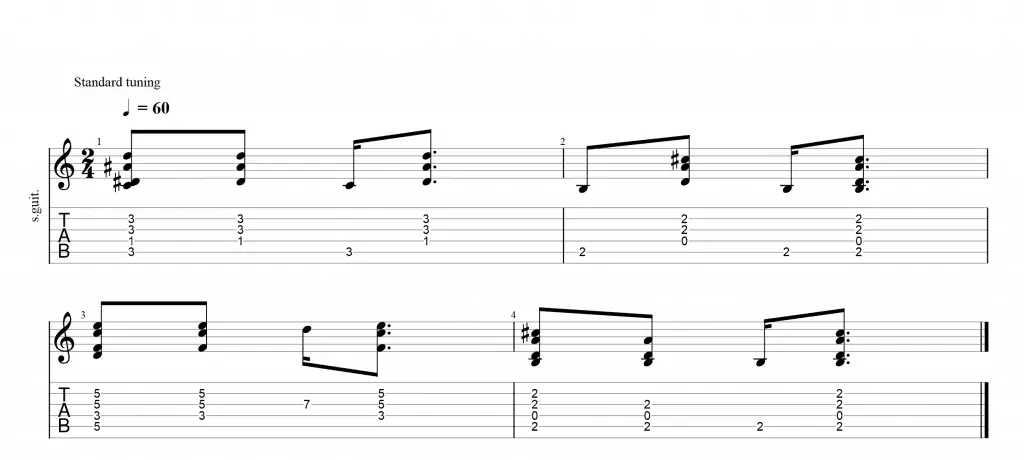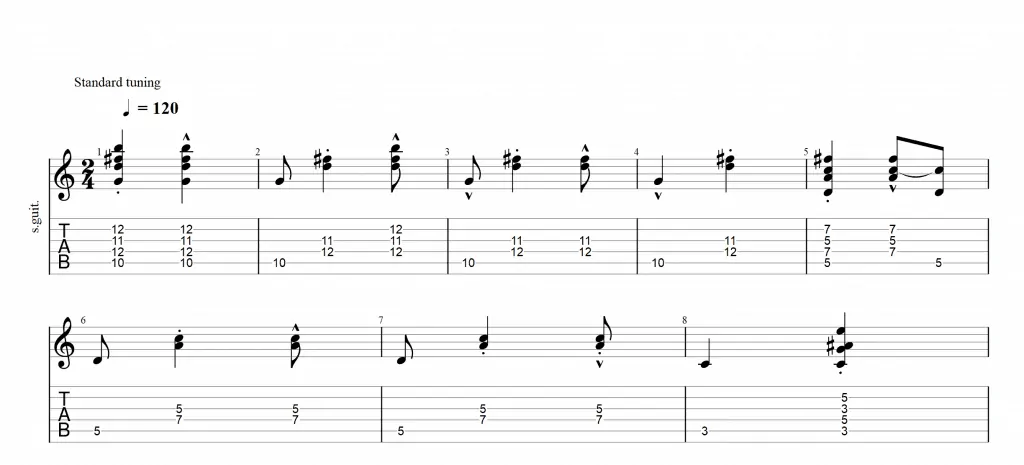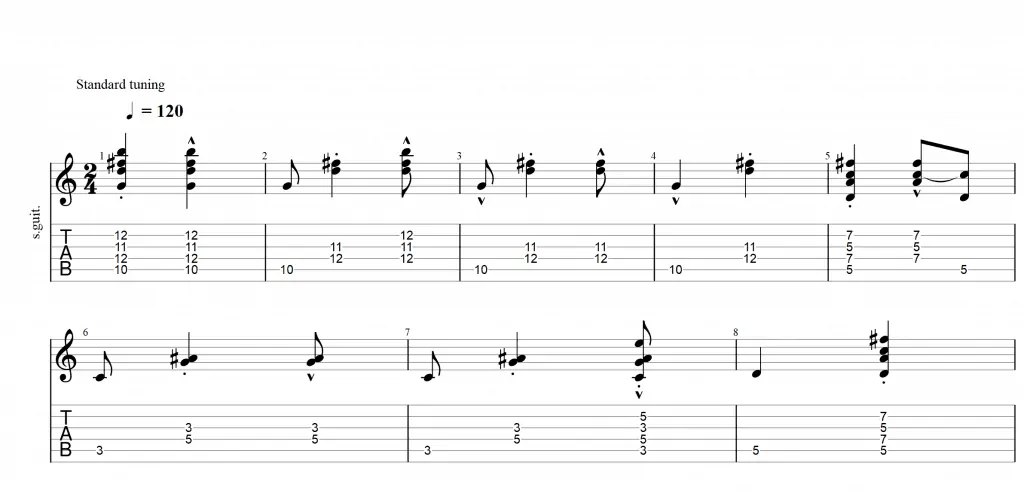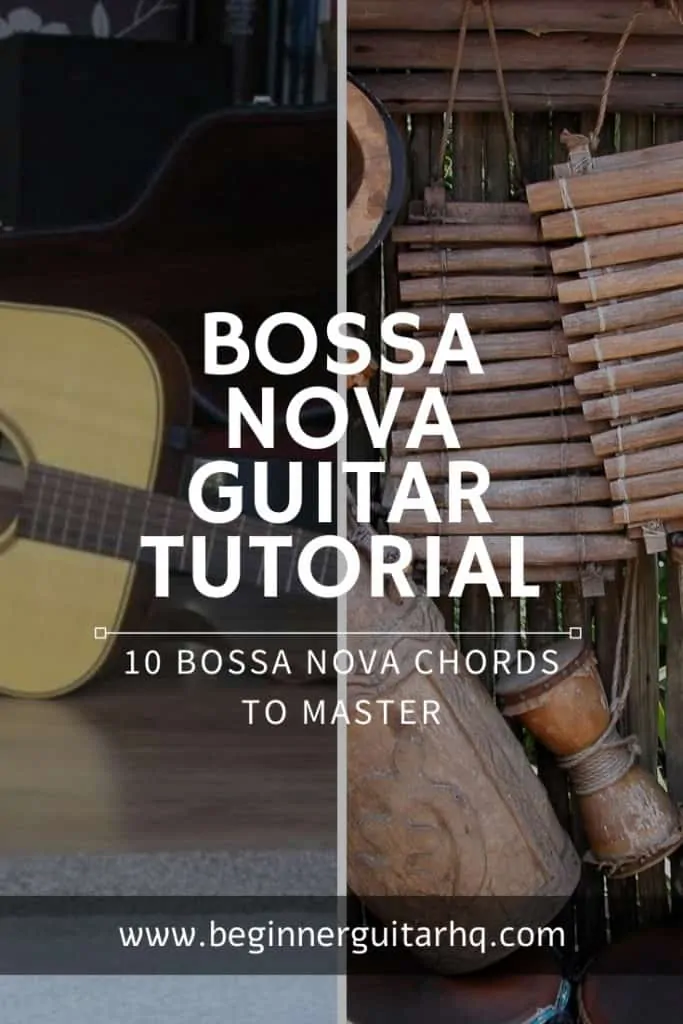I bet you’ve heard “Girl from Ipanema” by Sergio Mendes at least once in your life. It’s one of the most popular Bossa Nova songs ever, and Bossa Nova is a beautiful Brazilian version of American Jazz.
Little did you know Girl From Ipanema is the second most played and covered song in the world after The Beatle’s “Yesterday.” Do you want to play it as well?
This guide is here to teach you how to play bossa nova on guitar. I’m guiding you through its time signature, phrases, and bossa nova chords. By the end of the article, you’ll understand the genre so much you’ll be able to play your favorite bossa nova songs, compose your own tunes, or cover your favorite songs in this Latin American style.
Most of all, you’ll be able to jam, because I’m teaching you 10 bossa nova chords to master. Furthermore, I’m teaching you the rhythm patterns of bossa nova so you understand the genre both practically and conceptually.
This is a guitar guide for beginners better suited for intermediate players. I don’t recommend you take bossa nova as one of the first genres you play; instead, come here with some skills and knowledge and then expand your playstyle further with this beautiful musical genre.
In summary, you’ll learn how bossa nova guitar has a prominent roll in the genre, and the typical guitar combines chords with a bassline. The bass line and the chords of the guitar follow specific rhythms derived from a percussion instrument.
Usually, you would play this on nylon-strings acoustic guitars with your fingers. If you need some help choosing a classical guitar, check this guide.
My information is unique and features guitar tabs and audios so you can practice. If you have any questions, be sure to leave them below!
Contents
Following this guide, you will learn:
- What is and where did Bossa Nova come from?;
- How complex is bossa nova?;
- Musical elements of bossa nova;
- Playing bossa nova on guitar 101 (rhythm);
- Playing bossa nova on guitar 102 (groove);
- 10 bosa nova chords to master:
- Playing bossa nova on guitar 103 (progressions)
Before we go any further, I recommend you check this guide if you don’t know how to read a guitar tab, and check this guide if you don’t know how to read a guitar chord.
About Bossa Nova
Bossa Nova is a traditional Brazilian music genre that mixes American jazz with Brazilian samba and Portuguese or English lyrics.
Bossa Nova began in Rio de Janeiro, Brazil, in the late 1950s. A small group of middle-class students, musicians and artists came together to purposely create a new sound, which came to be the soft Brazilian samba genre known as Bossa Nova.
As it evolved from soft samba and cool Latin jazz, Bossa Nova is syncopated at 2/4 time. It means we need to study what syncopated means to truly understand the genre. Additionally, we need to understand the 2/4 time, as most time signatures we see and hear are the common 4/4 (4 crotchet beats per bar).
Guitarist Joao Gilberto and composer Antonio Carlos Jobin are considered the founders of the style. In particular, they began making music in the mid-60s while associated with Brazilian movements of social protests.
Still, Bossa Nova’s lyrics have a great deal of protest, love, loss, and happiness. I personally love bossa nova covers of popular rock songs.
The instrumentation tends to be simple and subtle. A bossa nova band has a guitar, a berimbau (musical bow), a bass, drums or percussion, sometimes a piano, and a singer.
As for the lyrics, they can be emotional, touching, protesting, or melancholic.
Lastly, as a dance, it works as a slow samba because it requires the same two-step feet movement and subtle body rhythm.
How complex is Bossa Nova?
Bossa Nova is a gentle sparse. The guitar dances in off time while pressing the beat notes, the low notes, on time.
You would play in a highly syncopated rhythm with “7th chords” and “9 chords” mostly. The complexity relies on understanding syncopation, in both theory and practice.
More so, you’ll have to learn about 7th chords, which are also used to play blues on guitar. And, lastly, you’ll need to rely on your thumb finger to play the beat notes.
As a guitar player, you’ll have to be able to play with your fingers instead of the pick. In particular, your thumb finger plays the bass notes, while the rest of your fingers play chords and additional fills.
The most important aspect, though, is the rhythm. And, see, there’s no central instrument, beat, percussion, or phrase serving as a foundation for the songs rhythm.
Having said that and because musicians need rules in order to learn something, there’s a particular rhythm bossa nova has which is known as “Bossa Nova clave.”
The drummer often plays as a motif, a guideline for the other instruments. However, as I said, Brazilian music doesn’t have a clave, which is why it sounds so relaxed.
Bossa Nova plays on major, minor, and blues scales. More on that later.
In case you’re wondering…
What is a clave?
A clave is a rhythmic pattern that serves as a tool to organize dance music. It’s present in African music, Latin jazz, mambo, son, salsa, merengue, reggaeton, reggae, dance hall, conga, son, cha-cha-cha, and similar genres.
Music genres that sound repetitive and formulaic have a clave. It’s not present in bossa nova, though, as this music enjoys more freedom.
The “Bossa Nova clave”, though, is a motif that repeats in most songs and something we’ll learn on the exercises on the sections below.
Musical elements of bossa nova
All Brazilian music styles have complex -composite- rhythmic structures. This is the result of having various percussion instruments playing in different rhythms at the same time. It creates what is known as composite rhythm or polyrhythm.
Playing polyrhythms on guitar involves extracting a single rhythm heard from the percussion ensemble, which might be the most prominent parts sometimes, or the most subtle parts on others.
Thus, you end up with different guitar rhythmic figures or phrases for bossa nova. So, we’ll define the basic building blocks of the genre as Beginner Bossa Nova Phrases. Before we begin, though, let’s review some basic musical elements so it’s all clear.
Meter
Meter (or metre) is the basic element holding music together. A meter is the time distance between two or more consecutive notes. In other words, the meter is the timing properties of notes or a series of notes.
Western music developed a series of equidistant pulses known as beats, which we tend to follow with our feet or feel like the overall rhythm of the song. In fact, science has discovered that as soon as we are exposed to sounds and music, we generate a series of equidistant pulses in our minds, a process researchers called “entrainment.”
Another interesting quality is how we perceive the first pulse of the pair as the strongest one. That’s why the clock makes “tick-tock” and not “tick-tick.” Go ahead, hear it in your mind. See how you create a meter and a strong beat automatically?
I always recommend you practice guitar with a metronome, so, when you go and practice your new bossa nova skills, get out your metronome and set the BPM between 50 and 140.
Musical figures
Musical figures determinate the length of a note within a bar in comparison to a beat. Each subsequent note is half the previous note.
| Musical figures | Lenght |
| Whole note | 4 beats |
| Half note | 2 beats |
| 4th note or Crotchet | 1 beat |
| 8th note | ½ beat |
| 16th note | ¼ beat |
| 32th beat | ⅛ beat |
Time signature
The time signature indicates the meter of the song, as well as how the beats are organized within a measure.
Such “measure” is known as “bar,” which, simply put, is a musical pattern containing an organized meter.
The number on the left indicates how many identical meter units are per bar, or how many beats per bar. The number on the right indicates how to count them:
- 4 means crotchet
- 8 means 8th note
It means a standard 4/4 time has 4 crotchets per bar, whereas a 2/4 has two crotches per bar.
Bar
The bar or measure is the segment of time that corresponds to a specific number of beats. It has boundaries on a musical sheet which are represented by thin lines.
2/4 time signature
A 2/4 time signature is standard in bossa nova music and other Brazilian styles. Let’s break it down:
- The “2” indicates bar contains two identical metric units;
- The “4” indicates each of these metric units is a crotchet;
- A 2/4 time signature means there are two crotchet beats per bar.
More so, in bossa nova, a musical phrase lasts 8 bars (or 4 bars in a 4/4 time signature). So, to make it easier for you, we’re calling the 1st and 5th beat main beats.
Let’s see it in the example below:
2/4 time signature is the standard timing for bossa nova. It just means 2 crotchets per bar.
Some people study and play bossa nova with a 4/4 time signature, which, in essence, doesn’t change anything but the accentuation.
Because I feel the 2/4 goes more naturally with the genre I’ll keep the 2/4 going forward, although I’ll also give some insight onto 4/4 bossa novas because you’ll find plenty of bossa nova tutorials with a 4/4 timing on the web.
Syncopation
Syncopation is the most important concept regarding bossa nova, and it’s an important feature in all Brazilian music.
A syncopation means delivering the notes at an unexpected time, which is often playing the notes on the odd beats rather than the strong beats while placing the staccato on the strong beats.
A syncope may have different strong-weak relationships than non-syncope songs. It depends on the phrase and other factors such as the accentuation of the syncopated beats.
There’re might be other ways to play a syncope which, in general, alter the perception of the meter and the accentuation of the beats. However, we’ll stick with the following formula:
Bossa Nova syncope:
2/4 time signature /Strong beats (lower notes) – Weak beats (chord notes) – If there are two consecutive chord notes, the second one is the strongest.
Beats and accentuation
As we divide each metric unit by two, we get twice the number of beats. And as we mentioned before, every pair of beats works with a strong-weak accentuation.
Every division of the metric unit gives you a new pair of beats. More so, every subsequent subdivision gives you a pair of strong-weak beats. If we go down the 16th note level, we’ll get two strong beats and two odd beats in that order.
Additionally:
- The 1st beat of every bar is the strong beat.
- The 1st beat of the 2/4 bossa nova time signature is the weak beat, because it’s syncopated.
- The pair beats of a 4/4 song are the strong beats (1 a d 3), however, the 3rd beat is weaker than the first
- The 2nd beat of a 2/4 beat is the weakest one; however, it’s the strong beat on bossa nova because it’s syncopated.
- The 1st beat of every phrase is the strongest one, as well as the first beat of every section (like a chorus or a verse). In bossa nova’s syncopated time, weirdly enough, the first beat of phrase’s last bar is the strongest one.
- A bossa nova phrase typically goes for 8 bars, which means the 2nd beat of the first bar, and the 1st beat of the last bar are the strongest ones.
It’s a bit complex to explain how to accentuate bossa nova because this issue is highly accentuated. More so, every song an work it out differently. You must trust your instincts and remember the accentuation must give the song a lot of subtlety and freedom.
In general, though, we accentuate the bass notes. If there are two consecutive chords, the first one is the odd one, while the second one is the strong one.
Here’s an example:
A common bossa nova progression featuring how we should handle the accentuation. See where the heavily accented notes are? On bars 4 and 8.
Special notation:
- The point above a note means “staccato,” which means playing the note or chord with more subtlety.
- The triangle pointing up means “Heavily accented note.”
- The triangle pointing right means “Accented note.
Keep in mind, a bossa nova song may also have a 4/4 time signature. With a 4/4 time signature, you would only change the accentuation.
Phrases and cadence
A phrase is like a musical sentence. It’s a motif, which means a rhythmical and harmonical motif repeating itself until it delivers the message.
A phrase may or may not have a singer; plus, it has a drum pattern, a bassline, and a guitar riff or chord progression, besides all of the other instruments making the musical arrangement. It repeats itself during a set number of bars, often times a pair number of bars that can be divided by 4 (4, 8, 12, 16, or 32).
The “sentence” maintains the same intensity over these bars and represents a section of the song (for example an intro, a verse, a pre-chorus, a bridge, a chorus, …).
Then, the cadence is like a musical punctuation. It’s a slight or pronounced musical arrangement that foretells the end of a phrase and the beginning of a new section of the song. A cadence also tells the next phrase will have more or less intensity than the previous phrase, even if it’s a cadence dividing a verse into two sections.
A bossa nova phrase -motif- commonly goes for 8 bars. If it’s a 4/4 song, it naturally goes for 4 bars.
It means the motif repeats itself after 8 bars and the phrase goes along until the section ends.
You would play bossa nova with a 2/4 time signature on your acoustic guitar instead of your electric guitar.
Rhythm
Rhythm is the combination of successive musical events; a musical event it’s either a note or a rest (the absence of a note, a silence).
More often than not, we identify repeating rhythmic combinations in the songs we hear. These combinations are mostly the bass and the drums, which belong to the rhythm section of a song. We can call these combinations of rhythmic patterns.
Next, a unique combination of rhythmic patterns represents a rhythmic phrase. Such a rhythmic phrase may change and evolve over the course of the song.
Bossa nova guitar voices
A bossa nova guitar produces harmony, melody, and also rhythm. We know these components as voices.
- The upper voices are the melody. In bossa nova, we play the upper voice with bossa nova chors while following the rhythm of the tamborim, agogo, or pandeiro.
- The lower voice is the rhythm. We would play this without thumb because the lower voice is usually single notes on the 6th string. Additionally, the lower voice follows the drums or surdo drums.
- The middle voice, the additional fills, is the harmony. It keeps together the other two elements. We’re leaving the middle voice out of this bossa nova tutorial, though, because it belongs in more advanced guides.
Composite rhythm
A composite rhythm represents two voices being played at the same time. For example, in bossa nova here’s what happens:
- The upper voice is playing chords mostly on the odd beats;
- The lower voices play the root notes mostly on the strong beats.
In essence, it just means your thumb, which plays the bass notes, will be playing on a different rhythm than the rest of your hand.
I know this sounds very complex, so we’ll review this in a more practical way in the next section, as we already saw all of the musical concepts we needed to understand bossa nova.
Bossa nova guitar follows the percussion’s rhythm.
Playing bossa nova on guitar 101: rhythm
We learned bossa nova guitar consists of three parts, each one having its own rhythm:
- The upper voice, which represents the chord progression;
- The lower voice, which represents the bass notes;
- The middle voice, which represents harmony.
Let’s tackle the first two individually and then combine them. We’re beginning with the lower voice as it’s the easiest one. Then, we’ll review bossa nova guitar chords and scales.
Bossa nova low guitar pattern
You play the bass notes with your thumb finger.
With a 2/4 time signature. What you need to do is play the root note for each chord on the first beat. If it’s a 4/4 time signature, then, naturally, you would play the root note on the 1st and 3rd beat of every compass:
These are the simple bossa nova guitar low notes. It’s not the same for every bossa nova song though, as the gene doesn’t have a clave. However, this is common enough for you to learn.
This is what we’ve got so far, and we can make it better. However, if you’re a beginner guitar player, you can stay at this level with no problem.
Now, you can make a bass fill on each odd beat. These fills are better in 8th notes (semi-crotchets).
As every song follows a chord progression, the odd fills can:
- Repeat the previous bass note;
- Anticipate the following bass note;
- Repeat the previous bass note an octave higher, or anticipate the following bass note an octave higher;
- Approach the following note chromatically (as in playing a note with one fret of distance, even if the said note is not part of the scale);
- Almost anything you can imagine as long as it keeps harmony and rhythm.
Let’s see it with an example with a song that goes E / B.
Fill the odd beats with 8th notes as you feel it better.
If you’re an intermediate guitar player, you can play this voice with your thumb. However, if you want to go a bit further, you may play this with your fret hand with hammer on techniques. More so, feel free to omit odd notes fills as you feel it wise.
You’ve got the gist of it, so let’s move into the next guitar voice.
Bossa nova melody guitar
Now we need to play the melody of the guitar on top of the bass guitar. We can do this by learning the melody itself of a song and repeating it. However, if you want to truly understand it, let’s instead review basic bosa nova rhythmic phrases in the next section.
Playing bossa nova on guitar 102: groove
The next step to play bossa nova is learning common bossa nova rhythm patterns where you can apply “7th chords” to.
These rhythms might be a bit hard to play at first, so I recommend you put the guitar down and first follow it with your foot or your hands. Also, put a metronome and clap the rhythm until it’s comfortable for you.
You should mentally accentuate the odd beats of the rhythm and feel it natural before you can play it.
Bossa nova guitar grove
One of the best things about bossa nova guitar patterns is how they have basically two layers, while the third one (harmony) is something you can omit.
In that way, the guitar lays down the whole groove and melody of a song. A piano can do it as well, but this is a guitar guide.
The first part of the groove is the bass notes, which we already covered. So, at first, you can play the bassline until you feel comfortable and then add the 2nd layer.
The most important thing to get the groove, though, is understanding syncopation, which relies on playing on the odd beat.
I have to add that bossa nova chords are mostly “7 chords” and “9 chords,” and we’re getting into that later on. In the meantime, you can read my previous guide about how to play bossa nova, because 7th chords are also for playing blues.
For now, we’re keeping it simple. Let’s do an exercise that can help you. It’s about playing a chord on the odd beat while playing the bass notes.
This pattern is more than enough if you’re a beginner guitar player. Also, for this example and the following example, the tabs on top are the lower voice guitar, whereas the tabs below represent the upper voice guitar.
Let’s get closer and closer to the genre. Now I’m sharing an exercise that represents how beginner guitar players often play bossa nova by ear. I’m not saying it’s wrong, it’s just the result of following the composite rhythms by ear without knowing the actual theory behind it.
A more advanced bossa nova exercise, good if you’re an intermediate guitar player.
Special notation
- The point (“.”) besides a metric unit is a “dotting.” It means the length of the unit is extended by half, so a 16th note with a dot would last 8th+16th.
The exercise above features the accentuations we talked about later, as well as some minor tweaks in the rhythm. It’s closer to what bossa nova actually sounds like on the guitar.
In the next section, we’re reviewing bossa nova fail-safe guitar rhythms…
Basic bossa nova guitar rhythms
Once you feel comfortable playing on chords on odd times and bass notes on the strong beats, you’re free to play actual bossa nova.
The following tab shows how to play bossa nova on guitar. It’s the melody part, the upper voice, and features the syncopation, accents, and silences required to create a bossa nova guitar line. I’m sharing the exercise with the E7 chord.
A common bossa nova guitar rhythm. Naturally, it belongs to the upper voice. What’s missing is the bass notes.
Once you feel comfortable with the chords, the next step is to add a bass line. I’ll add a B9 chord for the exercise. I’ll change the accentuation so you hear the difference. Remember the best way to handle the syncopated accents is by ear.
A bossa nova guitar featuring the upper and lower voices.
Special notation
- The arch connecting one metric unit to the next is a “Tied note.” It means you let the note sound instead of playing it again.
Now we have a progression going from E7 to B9. Common bossa nova progressions change the cord on the 5th 2/4 bar or every 8 beats. If you need some help finding out more interesting chords, check this guide.
Let’s add a bassline just to show you how it would sound with an ensemble. A simple bossa nova bass line just plays every two beats. The bassist can play either with half notes or crotches with a few arrangements on 8th notes. These arrangements a better placed on the 4th bar, preceding the 5th bar.
This tab features the guitar (upper and lowe voice) as well as the bass (on the F4 clef).
The bassline might be simple by itself, but it gives the song the solid foundation it needs. Mostly, it can’t be more complex because the guitar is syncopated.
Here’s an example of audio with a basic percussion. It will help you practice as it’s way longer than the previous audios. We’re also moving to a minor modification of this rhythm. I’m changing the chords to F7 and Cm9.
The only difference with the tab above is how it changes some 8th notes for crotches. You can hear the audio here, I made it about 1 minute long, with bass and percussion, so you can practice. Lastly, it also has the right syncopated accents. I decided to play one of the notes without any kind of special accentuation and found out it sounds better.
I must add that you can always play the 5th note as the lower note of the bass. The 5th note is usually the one exactly on the string below. However, do try to avoid this trick if the root note is only on the 6th string.
We’re now reviewing some professional bossa nova phrases. In other words, motifs we can find in famous songs of the genre.
Basic bossa nova phrases
We’re calling common bossa nova phrases “basic phrases.” These consist of strumming patterns that follow formulaic rhythms and accentuations. More so, you can find these patterns in many famous songs of the genre.
Furthermore, part of a bossa nova phrase can be used as a cadence.
Consider these as general suggestions: they will help you guide you through creating your own rhythm patterns and covering your favorite songs. Bossa nova can give you such liberties.
The next pattern comes out of the famous bossa nova song “Insesatez” (Joao Gilberto, 1961).
As you see, this is a different rhythmic pattern. I told you before bossa nova doesn’t have a clave because it enjoys larger freedom than dance music. We’ll review this rhythm a bit more with the bossa nova chords I’ll share in the next section.
Either way, I gave you a solid start on bossa nova guitar, and now I’ll give you a few tips regarding strumming hand techniques…
Bossa nova strumming hand technique
Every guitar player has its own strumming hand technique. However, I recommend you play bossa nova with your fingers or your pick and fingers.
You would play the bass notes with your thumb and hit the chord notes with your three fingers:
- The “A” and “D” strings with your first finger;
- The “G” string with the second finger;
- The “B” and “E” string with your third finger;
- The lower “E” string with your thumb.
You will need to make some smooth jumps alongside the neck to keep the bass lines going. If it becomes too hard for you, you can find closer 5th, 3rd or 8th of the root note you can play.
Lastly, keeping the groove going on is more important than playing super complex jazz chords. So, although bossa nova is a form of Latin jazz, I’ll keep the chords as simple as I can by just telling you what to play instead of sharing with you how to get there.
So, as this is not a jazz lesson, let’s just move on to the 10 bossa nova chords to master…
Develop a right-hand technique for bossa nova that feels comfortable and easy for you.
10 bossa nova chords to master
It’s time to spice up our bossa nova tutorial with 10 bossa nova chords to master. Using these chords with the rhythms and patterns and gave you before will give you beautiful results.
Alongside this list, I’ll give you some exercises and examples you can follow.
Lastly, I’ll explain how bossa nova chord progressions work, so I’ll need to talk a bit about scales.
Regarding scales, bosa nova’s chord progressions and chords are derived from either the major or minor scale, so when I say “3rd,” “5th,” or “7th,” I mean the 7th note of the major or minor scale of any given root note.
Major and minor scales
Let’s remember the formula for the major and minor scale. As I always do, I share my formulas with the “WH (whole-step) / H (half step)” formula. A step means the distance in frets between one note and the other.
- WH: whole step – It means two frets of distance.
- H: it means one fret of distance.
Now, a major scale goes whole, whole, half, whole, whole, whole, half (2,2,1,2,2,2,1).
And a minor scale goes whole, half, whole, whole, half, whole, whole (2,1,2,2,1,2,2).
This formula always starts from the root note, which is the 1st note of the scale. So, if we’re talking about the C major scale, here’s how we name the resulting notes:
| Note | Interval | Scale Degree | Steps |
| C | 1st / root note | Tonic, dominant | 2 |
| D | 2nd | Supertonic | 2 |
| E | 3rd | Mediant | 1 |
| F | 4th | Subdominant | 2 |
| G | 5th | Dominant | 2 |
| A | 6th | Submediant | 2 |
| B | 7th | Leading tone | 1 |
| C | 8th | Octave |
As for C minor:
| Note | Interval | Scale Degree | Steps |
| C | 1st / root note | Tonic, dominant | 2 |
| D | 2nd | Supertonic | 1 |
| Eb | 3rd | Mediant | 2 |
| F | 4th | Subdominant | 2 |
| G | 5th | Dominant | 1 |
| A | 6th | Submediant | 2 |
| Bb | 7th | Leading tone | 2 |
| C | 8th | Octave |
That’s all you need to know for now because, in fact, most chords come from the minor ar major scales.
I’m explaining a bit about the theory of each chord. However, I recommend that, instead of understanding how to build these chords theoretically, you remember the fingering (the position of your fret hand’s fingers when you do one of these chords) in order to create other chords in the same string by moving the fingering up and down the fret.
In summary, the following chords are moveable. Memorize them and adapt them.
Are you ready to master 10 bossa nova chords?
-
Cmaj7 & major 7th major chords
Major 7th chords are a triad (three notes of any given scale) of the root note’s major scale.
A major chord includes the root, the 1st, and the 3rd note. So, a C major includes C-E-G.
A major 7th chord adds the Leading Tone or the 7th note to the major triad. So, a Cmaj7 would have C-E-G-B:
You can transpose that fingering anywhere on the fret on the 5th string to get different chords. Simply put, the lower note (the one you should play with your index finger) is the root note or 1st.
So, with that simple formula, you can get 7th chords, which are good for bossa nova, blues, jazz, Latin jazz, and similar genres.
Another figure is:
What I love about 7 major chords is how you can play around them a lot. For example, you can play it with or without the root note, find a higher 3rd, play the bottom two notes only, and more.
For instance, here’s an exercise for you to play around the Cmaj7 chord with the bossa nova pattern from “A Girl from Ipanema.”
Playing around variations of the Cmajor7 chord with the bossa nova phrase pattern found in “A Girl from Ipanema.”
-
C7 & and dominant 7th chords
Dominant 7 chords are easier and give you a more haunting sound. You can play dominant 7 chords by combining the major triad with the minor 7th interval.
So, the minor 7th interval of C is Bb. It means C7 would look like this:
Just like major 7 chords, you can transpose this fingering anywhere on the fret on the 5th string to get different chords.
-
A7
There’s a chord I personally love because I find it both very easy to play and very beautiful. The chord is A7, and it looks like this:
Remember you don’t get to play the 6th fret. As for the first fret, I leave it for personal choice.
The next chord I love for bossa nova is…
-
E7
Every beginner guitar player creates songs around the E chord because it feels natural and easy, so needless to say I want you to master the E7 chord to play bossa nova.
Let’s put a cheat sheet…
– E major scale –
| Note | Interval | Scale Degree | Steps |
| C | 1st / root note | Tonic, dominant | 2 |
| F# | 2nd | Supertonic | 2 |
| G# | 3rd | Mediant | 1 |
| A | 4th | Subdominant | 2 |
| B | 5th | Dominant | 2 |
| C# | 6th | Submediant | 2 |
| D | 7th | Leading tone | 1 |
| C | 8th | Octave |
As you imagine, the chord looks like this:
Other than the E chord, 7th chords don’t sound particularly good on the 6th string, so don’t stress over the issue of transposing the chords on the 6th string. Instead, stick to playing 7th chords on the 5th string.
The thing is, you can play around the lower and higher versions, as well as the lower and higher E notes to play as the bass notes. Here’s an exercise that can help you master this bossa nova chord.
I’ll give you an exercise after a couple of chords…
-
E7sus4 & 7sus chords.
“Sus” stands for “suspended.” A suspended chord omits the 3rd note and replaces it’s with a 4th or a 2nd note.
SO, an E7sus4 would change the G#, which is the 3rd, for an A, which is the 4th.
It sounds too complex to remember it, I know, so I’ll just put the chord here:
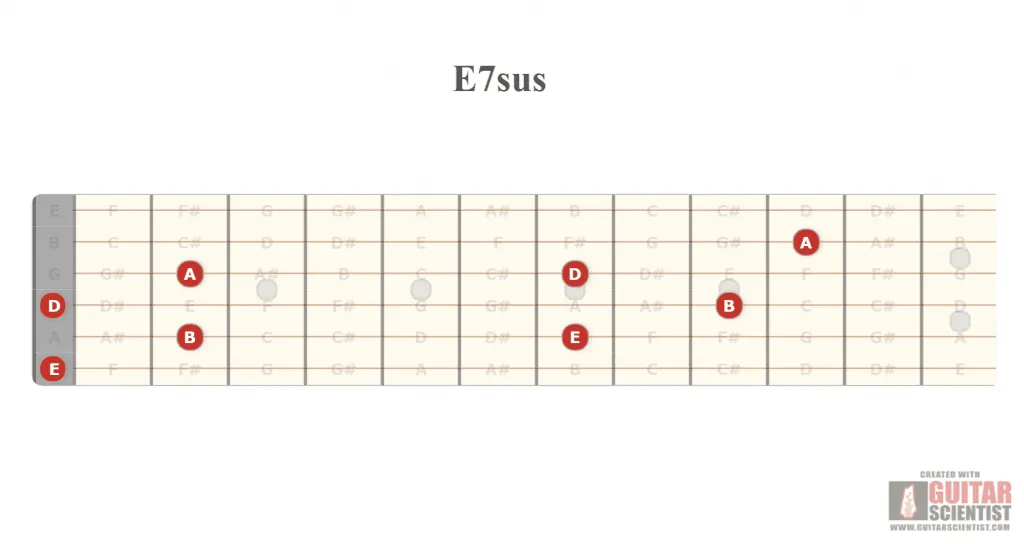
Let’s move on…
-
A7sus2
Now, let’s give you the A major scale table:
| Note | Interval | Scale Degree | Steps |
| A | 1st / root note | Tonic, dominant | 2 |
| B | 2nd | Supertonic | 2 |
| C# | 3rd | Mediant | 1 |
| D | 4th | Subdominant | 2 |
| E | 5th | Dominant | 2 |
| F | 6th | Submediant | 2 |
| G# | 7th | Leading tone | 1 |
| A | 8th | Octave |
Because I don’t want to complicate things further, I’ll just give you the chord and the exercise:
A7sus2.
So, what can you do with these chords? Master them first, and then you will be able to understand them.
Here’s the exercise (take a look at the strong-weak beats as well).
Remember to play around the figures of the different chords you’re using.
Here’s some more info about the guitar A chord.
-
Fm7 & minor 7 chords
I also want you to master minor 7th chords as they can give you additional tools for your bossa nova.
A minor 7th chord needs the minor triad plus the 7th note.
So, here’s the Fm scale:
| Note | Interval | Scale Degree | Steps |
| F | 1st / root note | Tonic, dominant | 2 |
| G | 2nd | Supertonic | 2 |
| Ab | 3rd | Mediant | 1 |
| Bb | 4th | Subdominant | 2 |
| C | 5th | Dominant | 2 |
| Db | 6th | Submediant | 2 |
| Eb | 7th | Leading tone | 1 |
| F | 8th | Octave |
The minor F triad is F-Ab-C, and the 7th is the Eb.
So, the Fm7 is:
Minor 7 chords are harder to play on the 5th string, so I recommend you transpose the figure on the 6th strings to the frets above to get different chords.
Let’s move on…
-
C9 & dominant 9th chords
A 9th chord includes the major triad plus the 9th and the minor 7th. If you’re wondering what the “9th” is like the “octave” of the original 2nd-degree interval note (of the major scale).
So, a C9 (C dominant 9) would have C – E – G -Bb -D.
Here’s how it looks (and hence how 9th chords on the 5th string would look like):
I shared the easiest guitar position of the 9th chord, so feel free to experiment with the chord.
Let’s go on to the counterpart…
-
Cminor9 & minor 9th chords
Similar to the chord above, a Cminor9 includes the minor triad plus the 7th and the 9th.
The easiest guitar position for minor 9th chords is also on the 5th fret:
Here’s an exercise:
Playing around the Cm9 with the pattern found in “A Girl from Ipanema.”
Let’s go on to the final bossa nova chord to master…
-
G13
I’m not even explaining 13th chords because it’s far too complex. Just remember the guitar position and adapt it. I shared this particular chord because it’s very interesting and it appears on many bossa nova songs.
If you want to know, here’s some extra info about G13.
It’s very hard to transpose this figure because there’s too much space between the notes. So I’m giving you another figure that omits the root note (G):
That’s a figure you can move up and down the fret on the 5th string. It will give you a jazzy, eccentric sound.
Additionally, here’s some extra insight about the G chord. It will give you a better idea about the forms we just studied (major, minor, and 7th).
So, by now, you have on your bossa nova arsenal some major and minor chords (naturally), dominant 7th chords, major 7th chords, minor 7th chords, 9th chords, minor 9th chords, and the G13 plus anything you can adapt into it.
Let’s move on…
Playing bossa nova on guitar 103: chord progressions
Bossa nova plays around with jazz chord progressions mostly. If you want some extra info about it, here’s some guidance about the three most famous jazz progressions for guitar players.
A chord progression is an order in which you play the chords, and that order is related to the scale. As music has been around for very long, there’s already plenty of knowledge about which progressions sound best and which genres combine better with certain progressions.
Feel free to always create, innovate and experiment though. However, chord progressions are your building block, your failsafe resource to songwriting, as well as understanding other people’s music.
Bossa nova, in terms of progressions and scales, is rather simple, as it usually follows the major or minor scales. It can also progress towards blues and pentatonic scales (you can read more about it here).
With that said, here are the two most common bossa nova chord progressions:
Bossa Nova chord progression 1: II-V-I
By “II-V-I,” I mean the progressions goes from the 2nd note of the scale to the fifth, and then to the first.
So, I’m sharing an exercise and let’s say the song is on C (because it’s the easiest scale).
| Note | Interval | Scale Degree | Steps |
| C | 1st / root note | Tonic, dominant | 2 |
| D | 2nd | Supertonic | 2 |
| E | 3rd | Mediant | 1 |
| F | 4th | Subdominant | 2 |
| G | 5th | Dominant | 2 |
| A | 6th | Submediant | 2 |
| B | 7th | Leading tone | 1 |
| C | 8th | Octave |
The progression usually goes like this: V(4 bars) / II (3 bars) / I (1 bar)
Bossa Nova chord progression 2: II – V – I – II
It’s also a very simpe progression that features 4 chords instead of three.
The progression usually goes like this: V(4 bars) / II (1 bars) / I (2 bars) / II (1 bar).
You can play around these progressions and the chords as you feel like it. I recommend you stick to the major scale for now.
With that said, I wish you good luck. Feel free to leave any questions below.


